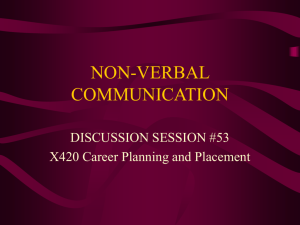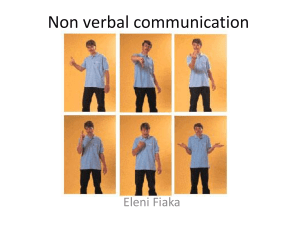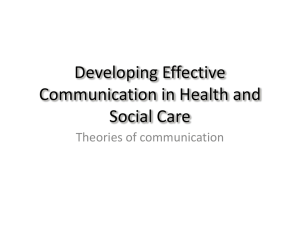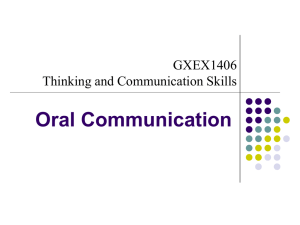Non-Verbal Communication
advertisement
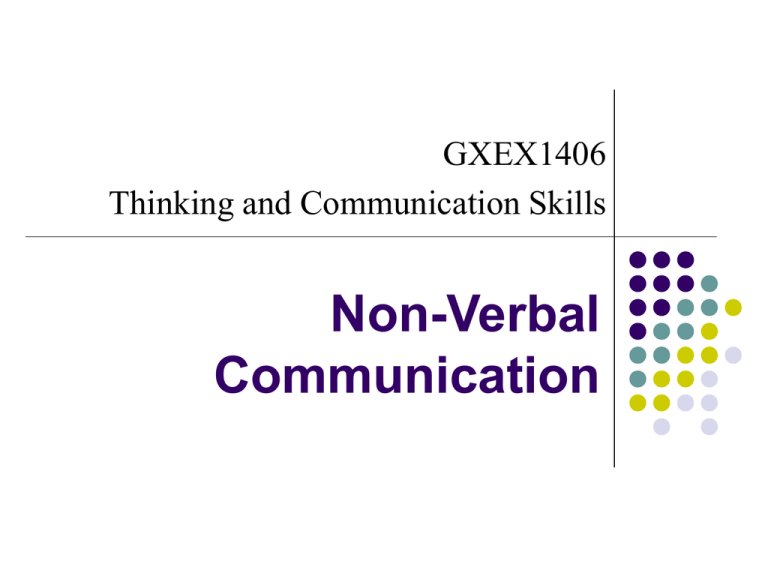
GXEX1406 Thinking and Communication Skills Non-Verbal Communication Non-Verbal Communication Objectives: Introduce types of non-verbal communication Show the importance of non-verbal communication to support a verbal communication GXEX1406 Thinking and Communication Skills – Week 4 Non Verbal Communication 2 Non-Verbal Communication Non-verbal communication makes no use of the words, sentences, grammar and other structures that we associate with spoken and written language. Non-verbal communication includes facial expressions, eye contact, tone of voice, body posture and motions, and positioning within groups. Verbal communication is organized by language; non-verbal communication is not. GXEX1406 Thinking and Communication Skills – Week 4 Non Verbal Communication 3 Non-Verbal Communication Types of non-verbal communication: Proxemics Orientation Eye contact or gaze Facial expression Gesture, especially use of hands and arms Dress Posture Paralanguage GXEX1406 Thinking and Communication Skills – Week 4 Non Verbal Communication 4 Non-Verbal Communication Other forms of non-verbal behaviour: Changes in our skin pigment such as blushing when we are embarrassed How much control do we have over the non-verbal signals we transmit? Smell Animal used smell to send out signals that both attract and repel Men/women used synthetic odours that will attract opposite sex GXEX1406 Thinking and Communication Skills – Week 4 Non Verbal Communication 5 1. Proxemics The study of how we handle the space around us, especially in relation to other people Human beings are territorial! We create for ourselves spaces that belong to us and to which we try carefully to control access Example: Our homes Our spaces at work or school Issue: how space is occupied is about how territory reflects the power relations within groups of people. The more powerful a person the larger and more impressive the space they will occupy GXEX1406 Thinking and Communication Skills – Week 4 Non Verbal Communication 6 Proxemics - continue Another important type of space; the space we carry with us Individual invisible space that we protect from outside intrusion Determined by the situation and by the relationship we have, or might like to have, with the person or people who are near to us Invisible bubble around us In crowded place such as a bus or train Cultural/religious differences in our attitudes to the proximity, or nearness, of other people “Don’t touch” – touching things, other people, or even our own bodies, is socially undesirable. Some cultures physical contact with relative strangers is openly encouraged GXEX1406 Thinking and Communication Skills – Week 4 Non Verbal Communication 7 Proxemics - activities Consider how space are occupied within the classroom. How is the teacher’s space marked out? How are other spaces occupied? Where would a newcomer or visitor to the class sit? What do you feel if you are in: A crowded bus A stadium A lonely beach GXEX1406 Thinking and Communication Skills – Week 4 Non Verbal Communication 8 2. Orientation Closely linked to the concept of proxemics The way in which people place themselves relative to one another When someone comes sits next to you, it is generally seen as a much friendlier (closeness) orientation than someone who sits directly opposite (potentially confrontational) to you. Activities Do we trust people more if they sit in certain positions in relation to us Why do we feel uncomfortable when people stand behind us? Describe how a detective ask a suspect of murder case. During interview, why interviewer sit apart from interviewee. GXEX1406 Thinking and Communication Skills – Week 4 Non Verbal Communication 9 3. Eye Contact Important way in which we communicate our feelings towards other people Initial eye contact to assess a stranger Staring – identified as threatening form or behaviour If we staring at someone, their behaviour will change, often becoming either defensive or at the other extreme aggressive towards you Deeply suspicious of people who ‘cannot look us in the eye’; they are seen as shifty or people with something to hide Gazing – look steadily; men gaze at women, sometimes in intimidating way Eye contact – can be an index of the closeness of a relationship that people share GXEX1406 Thinking and Communication Skills – Week 4 Non Verbal Communication 10 Eye Contact - continue A popular belief, “we can detect the truth in people’s eyes”. Although people may hide the truth with words, their true feelings will be revealed in their eyes However eye contact has some degree of ambiguity about its meaning (has the opposite meaning) GXEX1406 Thinking and Communication Skills – Week 4 Non Verbal Communication 11 4. Facial Expression We face other people when we talk Facial expression is bound to be an important indicator to other people of our attitudes, state of mind and relationships to them Human face has a complex arrangement of muscles that allows us to produce a whole range of different expressions, most of which are an index of our feelings (happy, sad, pain, etc.) Smiling – important facial gesture that indicate that we pleased to see other people GXEX1406 Thinking and Communication Skills – Week 4 Non Verbal Communication 12 Facial Expression - continue Smile vs Frown Smile in forced way Say “cheese” when a photograph is taken A smiling television presenter GXEX1406 Thinking and Communication Skills – Week 4 Non Verbal Communication 13 Facial Expression - Activities GXEX1406 Thinking and Communication Skills – Week 4 Non Verbal Communication 14 5. Gesture (Hands and arms) Gestures, e.g: handshake Changing their meanings over a period of time How to tell someone to be quiet in a library? We use gesture when our voice engaged, e.g: talking on the telephone, we used gesture to tell another person to come and sit down Many of the gestures are automatic. When we speaking on the telephone, we often make hand gestures Gestures that we make for pushing people away vs. drawing them towards us. GXEX1406 Thinking and Communication Skills – Week 4 Non Verbal Communication 15 Gesture - Activities 1. 2. In sport hand gestures are often used as a code for relaying information without opposing team being able to decipher it. Financial market and race tracks, employ extensive use of hand gestures for conveying information. Why? Watch a politician or other person addressing a public meeting either on television or, by attending yourself. Make a list of a different types of gesture they use. How does each of these gestures relate to the message being spoken? How do you, the audience, respond to different hand gestures? Any there any gestures that make you more inclined to accept the verbal message? GXEX1406 Thinking and Communication Skills – Week 4 Non Verbal Communication 16 6. Dress Dress – we combine items of clothing and the appropriateness of certain types of styles of dress to specific situation. Funeral – people wear black or dark coloured clothes as a symbol or mourning ~ avoid colour clashes. The clothes we wear make a statement about ourselves ~ interpretation by other people. GXEX1406 Thinking and Communication Skills – Week 4 Non Verbal Communication 17 Dress - continue Uniform – used to signify the role or function that a person performs; e.g: policemen, army, school children, etc. Also signifiers of the rank and status of the person who wears them. Have impact on the behaviour of both the wearer and those with whom they are in contact. Provide sense of belonging- to show our allegiance to a group (subcultures such as hippies, rappers, punks, etc. or support our football team or army etc.) Example of formal dress – business suit always dark shades? GXEX1406 Thinking and Communication Skills – Week 4 Non Verbal Communication 18 Dress - continue Time dependent dress code Office - formal Relaxing or socialising – casual Initial judgments about people because of their clothes Dress – one aspect of the physical appearance Hairstyle, jewellery, make-up, body adornment and body modification Open for interpretation by other people GXEX1406 Thinking and Communication Skills – Week 4 Non Verbal Communication 19 Dress - Activities How do you decide what to wear? Do you always have a choice? Are there clothes that you hate wearing? Do the clothes you wear make a statement about yourself? What is your attitude to school uniform? GXEX1406 Thinking and Communication Skills – Week 4 Non Verbal Communication 20 7. Posture The way in which we position our bodies Early age: “sit up straight”, “shoulder back” – instruction heard at home or school Upright posture – people who have confident (police, army) Posture is another sign of the status and role within society (army, police) Use posture as one means of indicating to another person our feelings of friendship or hostility “hands on hips” – confrontational and hostile Group – imitating the postures of the people they are with (mirroring, postural congruence) Cross legs, fold their arms Reinforce group identities GXEX1406 Thinking and Communication Skills – Week 4 Non Verbal Communication 21 Posture - Activities Make a list of postures that might be considered hostile. Make a list of postures that might be considered friendly. GXEX1406 Thinking and Communication Skills – Week 4 Non Verbal Communication 22 8. Paralanguage Those utterances that we make when we are speaking When we speak, we make noise that aren’t words (‘um’ or ‘ah’), we raise and lower voices, we pause, we stress some words Important aspect of the message when we are communicating E.g: “The house is on fire” ~statement “The house is on fire!” ~ stressed Voice intonation (pitch)- indicator of intention Flow of voice GXEX1406 Thinking and Communication Skills – Week 4 Non Verbal Communication 23 Paralanguage - Activities Accent and dialect are important aspects of paralanguage as they determine the way we sound to other people. Different regional accents are spoken with unique intonations and rhythms. Many of these accents carry with them connotations of the attitudes behinds the voice, many of which are obviously quite stereotypical. Consider following regional accents: Johor/Kelantan/N.Sembilan/Penang Do you have accent? How this make you react to these accents? Are the assumptions you might make correct about attitude and accents or dialect? GXEX1406 Thinking and Communication Skills – Week 4 Non Verbal Communication 24 The Link Most of time we use verbal & non-verbal simultaneously Issue: Which is more important (Verbal vs. Non Verbal) One of the functions of NVC – as a regulator (a mechanism that helps us to control the flow of conversation) Indications cues such as eye contact, facial expression GXEX1406 Thinking and Communication Skills – Week 4 Non Verbal Communication 25 Group Activities Group 1 Group 2 Group 3 GXEX1406 Thinking and Communication Skills – Week 4 Non Verbal Communication 26
